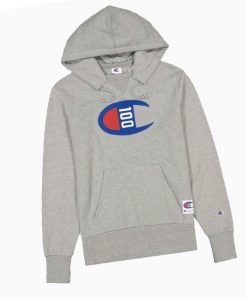
Champion® continues its 100-year focus on bringing quality and innovative athleticwear to teams around the globe.
By Jim Borneman, Editor in Chief
Champion® Athleticwear, a brand synonymous with team sports, is celebrating 100 years of serving athletic teams of all stripes. In 1919, the Feinbloom brothers — Abraham and William — founded Knickerbocker Knitting Mills in Rochester N.Y., with a focus on outfitting collegiate sports teams. The University of Michigan became the Feinbloom’s first major university association.
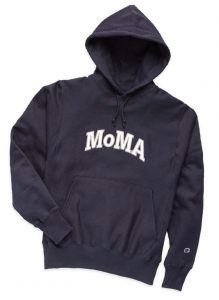
In the 1930s, Knickerbocker Knitting Mills became Champion Knitting Mills Inc., an in a short time, Champion had a presence at colleges and universities as well as physical education programs nationwide.
Innovation In Athleticwear
Champion gained ground in the team sports business by solving problems and improving the quality of athleticwear. Coaches and equipment managers had problems with uniform shrinkage of the uniforms as a result of constantly laundering the players’ gear. Champion set out to solve this problem, and on August 9, 1938, a patent was issued to Samuel N. Friedland of Rochester, N.Y., assignor to Champion Knitwear Co. Inc.
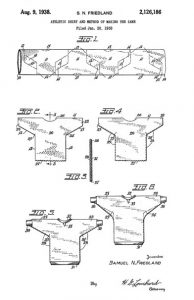
The patent, titled “Athletic Shirt And Method of Making The Same,” detailed a new way of fabricating “sweat shirts and jerseys.” Instead of cutting the garment’s front, back and two sleeves in the standard machine direction of the tubular knitted fabric, the fabric was rotated 90°, with the machine direction going from left to right. The garment was cut out of the tube in one piece using the top of the tube to form a continuous shoulder and sleeve. The top of the tube also allowed for a neck hole to be fashioned without requiring a seam. The under sleeve and sides of the jersey were then seamed, and cuffs and a collar added (see Figure 1).
This concept of rotating the machine direction rotated 90° became known and marketed as Champion’s “Reverse Weave.” Orienting the fabric in Reverse Weave reportedly fixed the shrinkage issues, eliminating the torso shortening and arm shrinkage that occurred in traditionally constructed jerseys.
On October 14, 1952, the U.S. Patent Office granted Friedland and William Feinbloom, assignors to Champion Knitwear Co, Inc. a new patent titled “Athletic Garment Or The Like.” The patent description states: “This invention relates, in general, to wearing apparel, and is directed more particularly, to improvements in the manufacture and construction of garments popularly known as sweat shirts and sweat pants which are worn by athletes and others engaged in sports and athletic activities, or the like.”
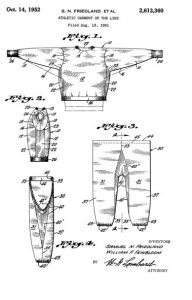
The patent illustration shows the reverse weave technique, but in this patent, the one-piece garment from the knit tube is replaced with a more complex construction featuring gussets and side panels. Also, both the jersey and sweat pant constructions are detailed (see Figure 2).
Staying Warm On The Sidelines
The 1970s and 1980s saw introduction of three significant products that help Champion remain popular and successful today.
According to the company, it created one of the most important athletic garments of the 20th century — the hooded sweatshirt. The “hoodie” was designed and developed for practical reasons and was first introduced as a warm up or sideline garment for athletes to wear in-between game time or practice sessions. Today, the garment is ubiquitous — worn daily everywhere from the athletic field to the school classroom and beyond. The hoodie achieved pop icon status and the Reverse Weave hoodie was permanently installed into the Museum of Modern Art in New York City in 2018.
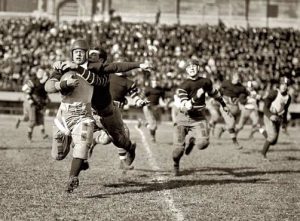
Reversible — Inside Out
Splitting into two teams in gym class was made easier when Champion introduced the Double Sided — or reversible — T-Shirt. The shirt could be manufactured in the school’s colors if desired and could be reversed from one color to another to indicate players on each team.
According to the company, Champion also was the first to design and manufacture a breathable nylon mesh fabric that became a staple fabric for basketball uniforms across the globe.
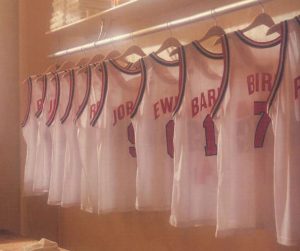
Outfitting The NBA
From 1989 to 1997, Champion was the official outfitter of the National Basketball Association (NBA). The company outfitted all 27 teams on the court as well as manufactured “authentic” merchandise that was sold off the court — a significant business for Champion at a very popular time for the NBA.
Champion also was selected to outfit the 1992 U.S. Olympic Men’s Basketball Team, the so-called “Dream Team” that went on to win the gold medal in basketball at the Barcelona Olympics. According to Champion, winning the gold medal “helped [the company] establish its reputation as an authentic, athletic apparel brand in Europe.”
Celebrating “100 Years For The Team”
To mark its centennial year, in January 2019 Champion announced a campaign that would focus on “what it means to be a team in 2019 from the perspective of participating teams, clubs, squads and crews across the world.” Throughout the year, Champion has highlighted and celebrated teams using social media, a special website, exclusive product collections, events and influencer partnerships. Select teams also were chosen to be featured in a centennial celebration video.
The campaign launched with a special film that features basketball legend Magic Johnson. In the film, Johnson shares his thoughts on what makes a great team. “As part of the ‘Dream Team,’ I experienced first-hand the power of people coming together to achieve great things,” Johnson said. “I’m pleased to celebrate the power of teams in Champion’s 100th anniversary campaign.”
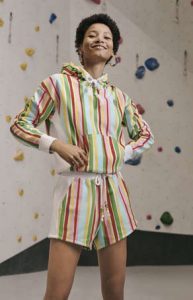
“This significant milestone for Champion allows us to reflect on what ‘team’ and the evolution of ‘sports’ means today to consumers around the globe,” said Jon Ram, group president, global activewear, Hanesbrands Inc. Today, Champion is part of Winston-Salem, N.C.-based Hanesbrands’ portfolio of apparel brands. “Helping people come together as teams and being innovators in the industry has been an important part of our brand’s story since the very beginning. Now is the time to look ahead and celebrate how teams today have the power to change the world for the better, and how we assist in enabling them.”
One Hundred And Counting
From its humble beginnings in Rochester to growing into one of the world’s most established brands, Champion’s centennial is a true testament to Abraham and William Feinbloom‘s vision — outfitting the team with quality and innovative athleticwear — while celebrating the power of team identity.
Today, Champion maintains its focus on the team and also has had a resurgence in pop culture with successful collaborations with streetwear brands, including BAPE® and Supreme.
As this lineage of quality and innovation continues, Champion’s history supports its future — and the future looks bright.
September/October 2019




